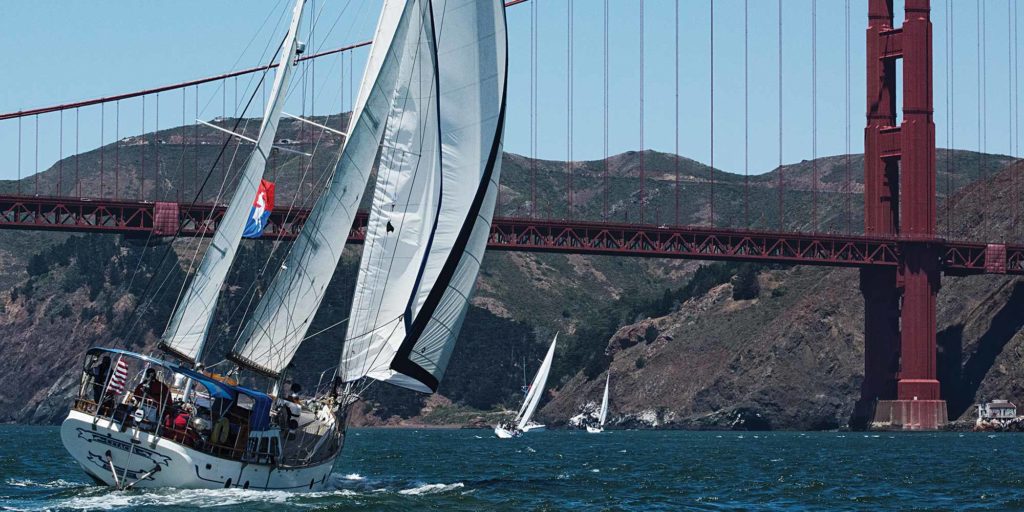
It was almost sunset late last July on the docks in Kaneohe, Hawaii — the finish line for the biennial Pacific Cup yacht race, and a long way from the start in San Francisco — when the Hanse 505 Anaïs glided alongside and came to a halt. Moments later, a full-on dock party was raging as the last rays of sun spilled over the Pali mountain range. Skipper Matt Solhjem looked back at his Hanse in disbelief before reviewing the list of carnage. From blown-out spinnakers to broken electronics, the passage had taken its toll. The look on Matt’s face told a story: humbled, gracious and fully content, but also mischievous, like a teenager who’d just pulled one over on his parents. Winding down from a 12-day-long adrenaline rush, the first-time ocean racer said, “That was definitely a race. Right off the bat, the other boats were pushing hard. Even though we were sailing in the cruising class, that was a race, for sure.”
For the crew of Anaïs, it was also a successful one; they were the winners of the 14-boat cruising division, the largest in the race.
Bluewater cruising rallies and offshore yacht races have been the catalyst for an untold number of sailors to set sail and turn their dreams to reality. With a dedicated support and preparation network, as well as the perceived safety of traveling in a group, many sailors who might otherwise be hesitant to head offshore have found the proposition far less daunting when presented with the option of doing their first major crossing as part of an organized event. Nicknamed the “fun race to Hawaii,” the Pacific Cup has traditionally been a semi-laid-back affair that includes everything from Maxi racers full of pro crews to doublehanded Moore 24s sailed by intrepid amateur sailors, with everything in between.
The Pacific Cup has an interesting history. On June 15, 1980, 40 yachts sailed out under the Golden Gate Bridge in what was then called the Kauai Race, from San Francisco to the “garden island” of Kauai. Almost immediately, they were pasted by rough conditions. Attrition ensued, but 10 days later, Bill Lee’s legendary Merlin (the predecessor to the venerable Santa Cruz 70) was the first boat to come surfing into the islands. Easily the fastest yacht in the race, Merlin arrived in Kauai close to four days ahead of the next boat; the celebrated 68-footer also won a commanding victory on corrected time, establishing a long tradition between 70-foot sleds and success in the Pacific Cup. The Division II winner back in 1980 was Dean Treadway and his legendary Farr 36, Sweet Okole. Nearly 40 years later, in 2018, the same skipper and boat came power-reaching into Hawaii to earn a very close second place in their division, only narrowly missing out on victory due to an unfortunate wind shift in the final miles.
Since that inaugural race in 1980, the event outgrew its humble beginnings, was renamed the Pacific Cup and relocated its finish to Kaneohe, on the island of Oahu, to accommodate more boats. Yes, there are still plenty of glitzy raceboats and famous sailors, but the event has also always attracted local sailors who get their hands on a modest ultralight racer and dream big. While no small ultralight boats sailed in that first race, they have since become a fixture. From Moore 24s and Express 27s to Santa Cruz 27s, Olson 30s and Hobie 33s, the Pacific Cup attracts a great number of those early surfing boats from the heyday of the Santa Cruz boatbuilding era. In 2018, the race enjoyed a once-in-a-lifetime battle between seven Express 27s (six sailed doublehanded in their own one-design fleet, while one sailed in a PHRF handicap division with three crew on board). The little 27-foot speedsters and their crews put on a performance that will be talked about for many years to come.
The look on the skipper’s face at the finish line told a story: humbled, gracious and fully content, but also mischievous, like a teenager who’d just pulled one over on his parents.
After a gnarly super El-Niño impacted the race in 2016, when major tropical weather systems moved across the racecourse in quick succession, the vibe on the docks at the hosting Richmond Yacht Club in Point Richmond, California, was decidedly more relaxed in 2018. All of the weather models pointed to a much more traditional, if not benign, race. With an incredible two-thirds of the 60-boat fleet being first-time race entrants, no one was complaining about the mellow forecast. With light winds, warm temperatures and sunny skies at the race village, one could have been forgiven for confusing Richmond with the race finish. The 60 entries were spread across eight divisions over four different starting days in mid-July, with the goal being to get everyone into Kaneohe around the same time. It was the third time a dedicated cruising class was included, with the first coming in 2014.
“A lot of goals came together to get the cruising fleet added to the Pacific Cup,” said Pacific Cup Yacht Club commodore and eight-time race participant Michael Moradzadeh. “First, we wanted to make the race more accessible to some folks who might feel intimidated by racing all the way to Hawaii. We relaxed the rules a bit — but not in terms of safety — to allow boats to motor a bit if needed, or to call a coach or weather router for advice, things you normally can’t do in a yacht race. We thought that the sailors wouldn’t be too competitive, but as it turns out, any time that you get two or more boats on the water it’s most definitely a race! For 2020, we’re probably going to configure the fleet a bit more like a race with actual handicap ratings and scoring, though still allowing the cruisers to use their engines if necessary. Competitive cruising, if you want.”
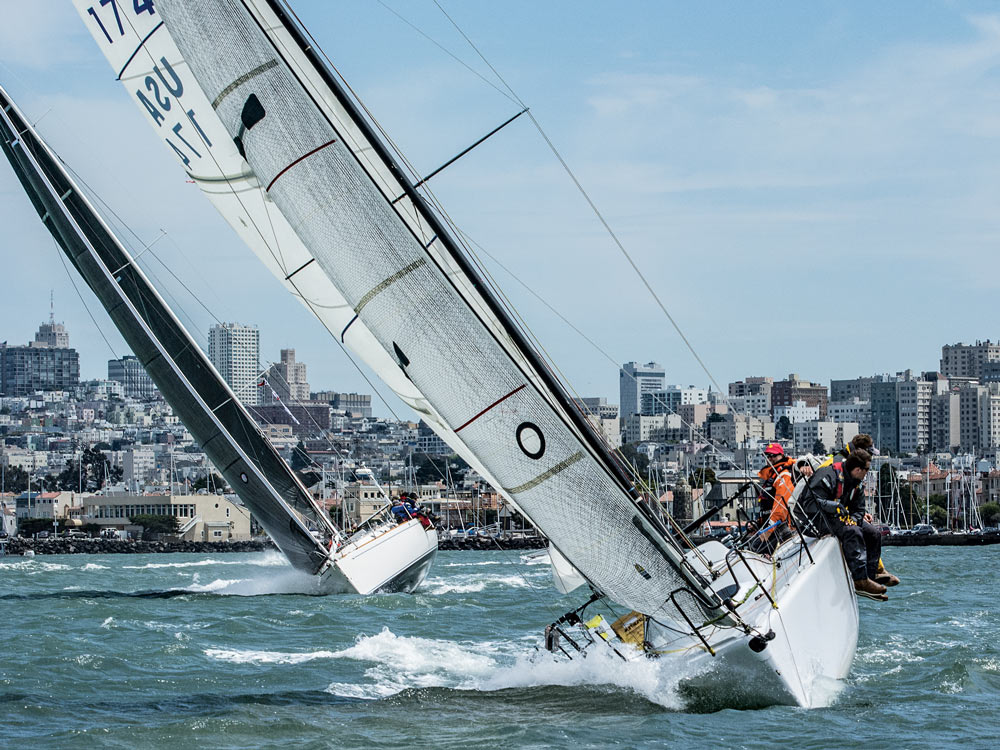
Competitive cruising is a polite way to put it. In the 2018 Pacific Cup, two 50-foot sisterships were duking it out near the head of the fleet, with top-tier sailing talent on board both boats. On Emmanuel Sauquet’s Hanse 505, Outremer, a crew of six Frenchman, including Vendée Globe superstar Tanguy de Lamotte, found themselves locked in an intense match race with the aforementioned Anaïs, which was stacked full of seasoned racers from San Diego, including the local Ullman Sails pro, Chuck Skewes. While Outremer tended to have a slight speed advantage at times, the two boats took wildly divergent routes to Hawaii, which ended up being the deciding factor.
In solidarity with the Frenchmen on board A Fond le Girafor, a revolutionary new foiling Beneteau Figaro 3 in the doublehanded class, who were just ahead of them, Outremer played the north side of the racecourse while rival Anaïs played the south. Up north, the route would be much shorter, and in theory, there would be a narrow corridor of increased pressure for any navigator who was skilled and daring enough to try to thread the needle and find it. Down south, the conditions looked a bit softer, though considerably more consistent with fewer wind holes to deal with. The boats up north looked good in the short term, but as is usually the case when racing to Hawaii, those northerly boats faded hard in the middle stages of the race. When the wind finally went light for the northerly boats, Anaïs gained a big advantage and held on to the finish to arrive into Kaneohe some 12 hours ahead of her French competition.
As is often the case in races from California to Hawaii, the boats that opted for a northern route faded hard in the middle stages of the voyage.
The arrival of Anaïs signaled the start of a marathon push for me, the race’s media guy, that would last for much of the following week. After that first cruiser came in, the floodgates opened and boats were finishing around the clock. With so many interesting storylines to follow and friends spread throughout the fleet, seemingly every few hours I would attempt to greet and cover a boat, no matter what time of day. From high-energy arrival parties to heartwarming reunions among loved ones, each arrival was different from the last, but equally special.
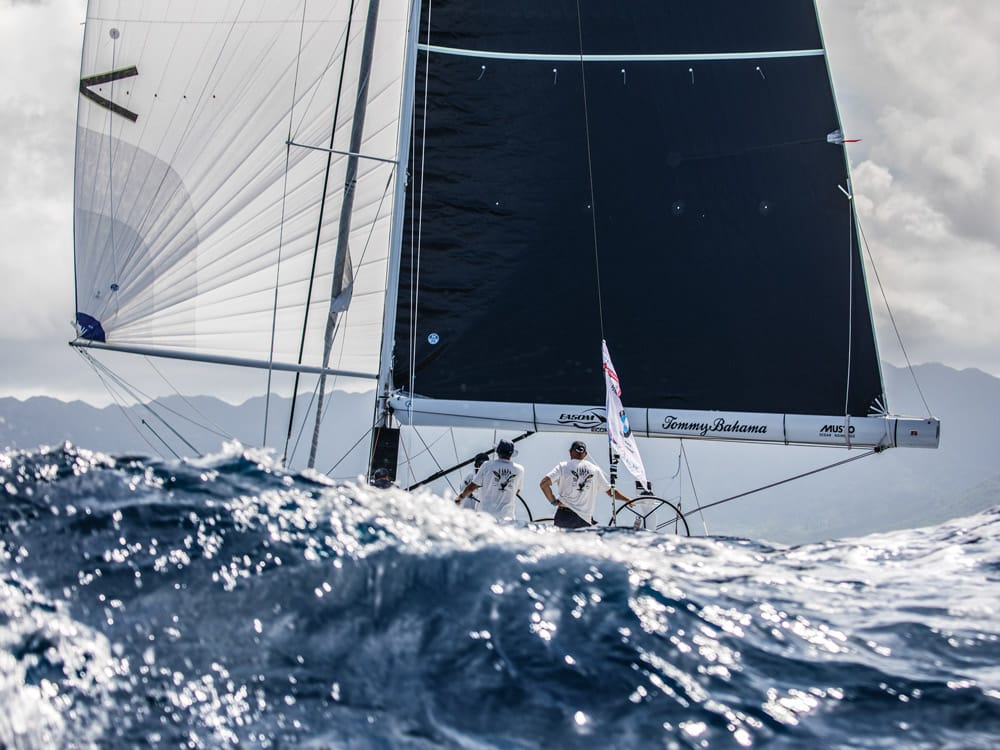
I’ve always had a soft spot for the French and their passion for sailing, and because this year’s fleet had such an incredible number of French sailors, it was fun and exciting to greet them in Hawaii. Perhaps the most touching of all finishes in the 2018 Pacific Cup was when Nicolas Thiebaud’s all-French crew on his Jeanneau SunFast 3200 Dare Dare arrived in the middle of the night to a raucous welcoming committee that included a huge French contingent singing an old Breton song in honor of their fellow countrymen. When you engage in an organized sport like ocean racing, you do it as much for the community as you do for the voyage itself. To see the love and camaraderie among competitors is perhaps the most beautiful part of the whole event; it’s one big celebration of the sport, among friends both new and old.
Aside from the two modern 50-foot Hanses with wicked-up crews that found themselves in an improbable match race for the lead, the rest of the 14-boat cruising fleet spanned the full spectrum of cruising yachts — a Mason 44, Island Packet 380, Nordic 44 and Swan 441 were among the entrants — with a wide array of proper cruisers and comfy racer-cruisers also sprinkled throughout the racing fleets.
As well as the diversity of boats entered, the ambitions and vibes of the various different crews is hard to miss. Obviously, a lot of the fleet is composed of hardcore racing sailors who thrive on the intense competition and the thrills that only high-speed open-ocean surfing runs in the trade winds can deliver. For others, it’s their own personal Everest, the culmination of a major life undertaking amid years of dreaming. While for many still, it’s merely a summer tradition, a break from work or an ambitious summer cruise. For all, however, it’s a long bluewater passage with day after day of off-the-breeze sailing in ideal conditions before arriving to a warm welcome in paradise. Whether racing or cruising, the sail from California to Hawaii is about as good as it gets.
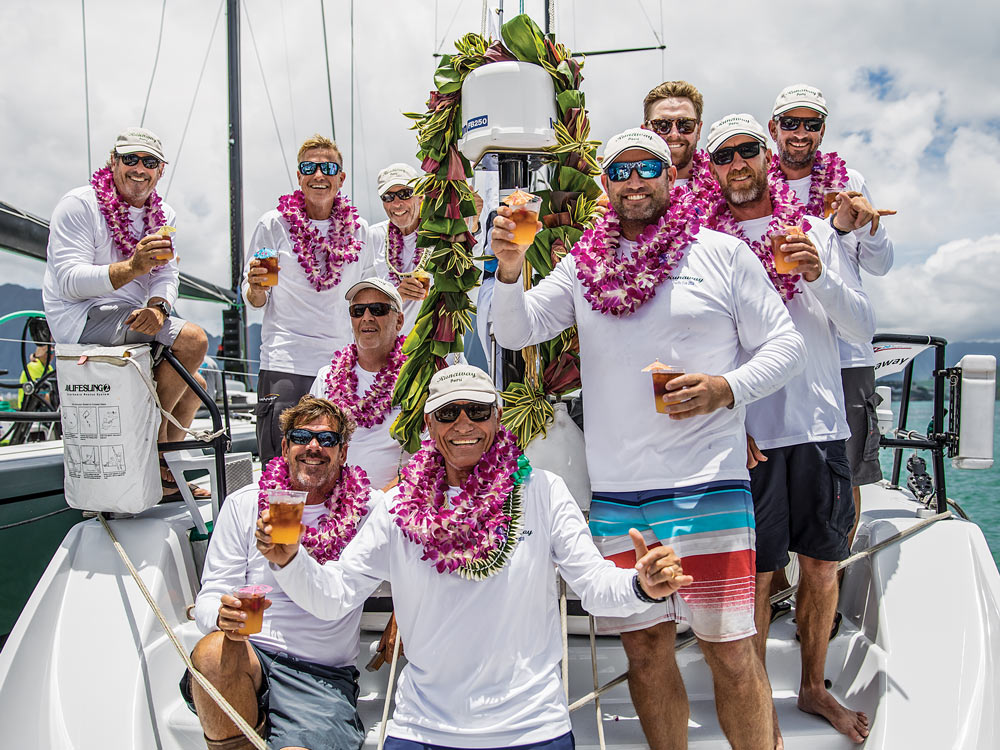
For many, the race itself is just a part of the motivation for entering the Pacific Cup. Russ Johnson, skipper of the Jeanneau 52.2 Blue Moon, said, “Probably the biggest part of the Pac Cup, for me, was to be able to do the return trip and go through the Great Pacific Garbage Patch. I learned about the gyre 15 years ago and was surprised at how many people had still never heard of it. I wanted to see what was out there for myself, and make my findings available to raise awareness and educate people about what it is.”
Before returning to California, and visiting the garbage patch along the way, Johnson found himself on island time, and his return delivery was delayed a couple of months by impromptu local adventures. “The sailing was absolutely beautiful. From almost any port, you can be out in the ocean in minutes and have reliably great breeze and open-ocean sailing. Within hours, you can find another port or another island entirely to pull into and meet new people. We visited the remote north side of Molokai. It was amazing and completely unexpected. With the tallest sea cliffs on earth, beautiful waterfalls and hidden coves, it was the real Hawaiian paradise that I had hoped to find.”
Not all boats that sail in on a Pac Cup make the return, however. Some skippers sail their boat into Hawaii, effectively on a one-way journey, before selling the boat in the islands and flying home. For so many others, however, the Pac Cup is just the beginning of the journey. Warren Holybee and crew sailed his Morgan 382 Eliana into Kaneohe in 14 days to grab third place in the Coral Reef Sailing Apparel A division. The next time we saw Warren, he was in Honolulu installing a Monitor windvane and dodger that he had shipped out with the delivery gear. From Hawaii, he cruised on to Fiji and will be heading on to New Zealand.
For Thiebaud, a young French sailor who lives in San Francisco, the Pac Cup was part of his spiritual journey to sail to the islands of French Polynesia. As soon as the Pac Cup was over, he was seen loading big ground tackle, a dinghy and other cruising gear onto his 32-footer Dare Dare and heading south. Overall winner Prospector, a flashy, modern 68-foot racing yacht, sailed onward to Sydney with its professional crew for a run at the Rolex Sydney-Hobart Race. The Pacific Cup was just one leg of a racing circumnavigation that includes many iconic ocean races. Just like the diversity of the fleet itself, when the awards party ends, an equal if opposite number of adventures ensue.
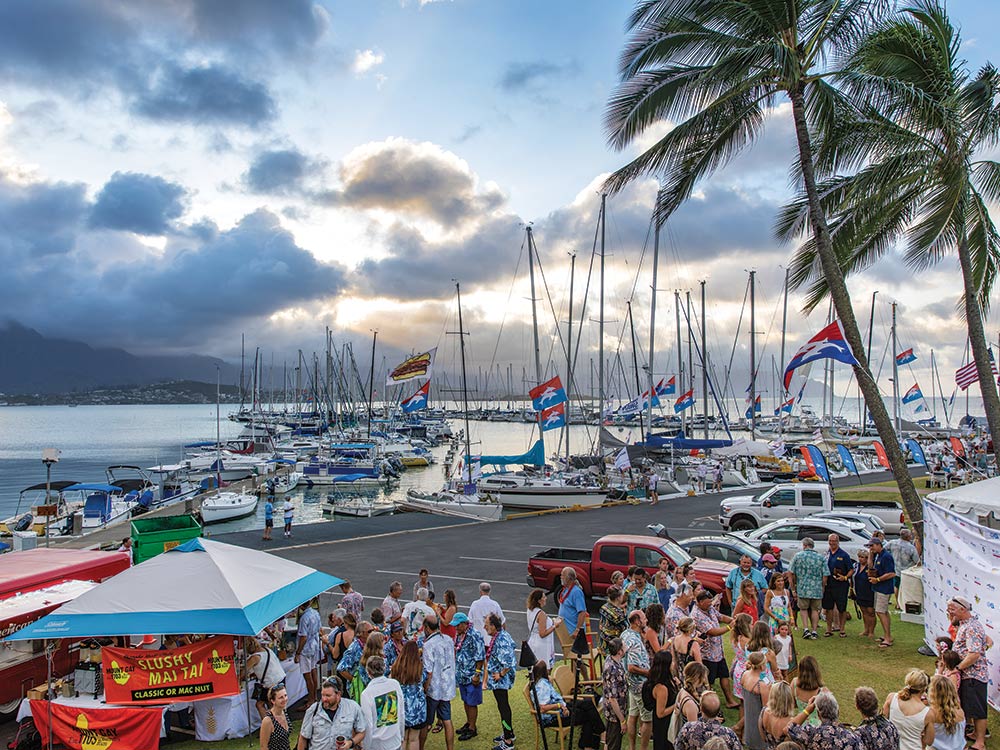
Back in 1980, the first year of the Pacific Cup, Lester Robertson raced a Moore 24 named Legs to the island of Kauai in the 1980 singlehanded Transpac. Nearly 40 years later, he was back, this time doublehanded, to race another Moore 24 called Foamy to Hawaii. “I decided to do the race, and then two and a half months into the rebuild I was diagnosed with a rare form of liver cancer. They told me I had a 15 percent chance to survive the first five years, but I always figure we can be in the top 15 out of 100,” he told me with a forced chuckle. “There’s so much else in life, but it was one of the things that I really, really wanted to do — another transpacific voyage in a small boat — and I’m just so grateful and privileged to be here. I appreciate it so much. There’s just so many other ways it could have worked out.” Lester and his crew, Randy Parker, pushed the venerable Moore 24 hard, fighting for the victory for much of the race, ultimately finishing in third place in the division and only narrowly missing out on second.
You talk to a guy like Robertson, or a first-timer, or a 15-time race vet, or even a race volunteer, and you realize how much the Pacific Cup means to this crowd. From the opening race village at the Richmond Yacht Club to the finish-line festivities at the Kaneohe Yacht Club, there is an overwhelming sense of pride and gratitude in being part of it: gratitude for the incredible and oftentimes humbling experience, and pride to be a part of something so undeniably special and uniquely homegrown. With a dedicated group of volunteers and many of the usual suspects among the competitors, the fleet has a family feel to it and takes great pride in ownership of their little race that has left such an indelible mark on the sailing world. With this tightknit group that warmly welcomes outsiders and newcomers, including cruisers, the time has never been better to cast off the dock lines and discover the Pacific Cup for yourself. The next Pac Cup is scheduled for 2020. How about joining the fun?
Ronnie Simpson is a sailor, surfer and sailing media professional who is in the early stages of a surf-focused sailing circumnavigation on his Peterson 34, Quiver. Having recently completed a degree in integrated multimedia from Hawaii Pacific University, Ronnie continues to pursue his goals as a sailing journalist alongside — and to help fund — his own sailing ambitions. He was the media director for the 2018 Pacific Cup.








